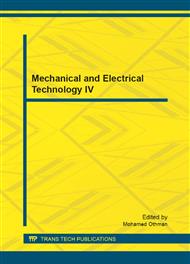[1]
J. Tierney, C Rader, B. Gold, A digital frequency synthesizer, IEEE Transaction on Audio and Electro acoustics, Vol. 19, No. 1, pp.48-57, March (1971).
DOI: 10.1109/tau.1971.1162151
Google Scholar
[2]
J. Jiang and E. K. F. Lee, A low-power segmented nonlinear DAC based direct digital frequency synthesizer, IEEE J. Solid-State Circuits, vol. 37, no. 10, p.1326–1330, Oct. (2002).
DOI: 10.1109/jssc.2002.803047
Google Scholar
[3]
X. Geng, X. Yu, F. F. Dai, D. Irwin, and R. Jaeger, An 11-bit 8. 6 GHz direct digital synthesizer MMIC with 10-bit segmented sine-weighted DAC, IEEE J. Solid-State Circuits, vol. 45, no. 2, p.300–313, Feb. (2010).
DOI: 10.1109/jssc.2009.2037542
Google Scholar
[4]
X. Geng, F. F. Dai, J. D. Irwin, and R. C. Jaeger, 24-bit 5. 0 GHz direct digital synthesizer RFIC with direct digital modulations in 0. 13um SiGe Bi CMOS technology, IEEE J. Solid-State Circuits, vol. 45, no. 5, p.944–954, May (2010).
DOI: 10.1109/jssc.2010.2041398
Google Scholar
[5]
A. M. Sodagar, and G. R. Lahiji, Mapping from phase to sine amplitude in direct digital frequency synthesizers using parabolic approximation, IEEE Trans. on circuits and systems-II: analog and digital signal processing, vol. 47, no. 12, pp.1452-1457, Dec. (2000).
DOI: 10.1109/82.899639
Google Scholar
[6]
J. M. P. Langlois, D. Al-Khalili, Novel approach to the design of direct digital frequency synthesizers based on linear interpolation. IEEE Trans. Circuit Syst. II, Analog Digital Signal Process 50(9), 567–578(2003).
DOI: 10.1109/tcsii.2003.815020
Google Scholar
[7]
H. Jafari, A. Ayatollahi, and S. Mirzakuchaki, A low power, high SFDR, ROM-less direct digital frequency synthesizer, in Proc. IEEE Conference on Electron Devices and Solid-State Circuits, pp.829-832, Dec. (2005).
DOI: 10.1109/edssc.2005.1635406
Google Scholar
[8]
J. -M. Huang, C. -C. Lee, and C. -C. Wang, A ROM-less direct digital frequency synthesizer based on 16-segment parabolic polynomial interpolation, in Proc. 15th IEEE International Conference on Electronics, Circuits and Systems, pp.1018-1021, Sept. (2008).
DOI: 10.1109/icecs.2008.4675029
Google Scholar
[9]
X. Li, L. Lai, A. Lei and Z. Lai, A direct digital frequency synthesizer based on two segment fourth-order parabolic approximation, IEEE Trans. on Consumer Electronics, vol. 55, no. 2, pp.322-326, May (2009).
DOI: 10.1109/tce.2009.5174388
Google Scholar
[10]
R. A. Freeman, Digital sine conversion circuit for use in direct digital synthesizers, U.S. Patent 4 809 205(1989).
Google Scholar
[11]
S. -I. Liu, T. -B. Yu, H. -W. Tsao, Pipeline direct digital frequency synthesizer using decomposition method. IET Journal 148(3), 141–144(2001).
Google Scholar
[12]
E. Murphy, C. Slattery: Direct Digital Synthesis (DDS) Controls Waveforms in Test, Measurement, and Communications, Analog Dialogue 39-08, August (2005).
Google Scholar


